#indian zoo authority
Text
Good News - July 8-14
Like these weekly compilations? Tip me at $Kaybarr1735! And if you tip me and give me a way to contact you, at the end of the month I'll send you a link to all of the articles I found but didn't use each week!
1. Zoo welcomes birth of four endangered horse foals

“[The Marwell Zoo in GB] said it was "delighted" to welcome the arrivals to the endangered Przewalski’s horse herd. All four are female and said to be "doing well" after two were born in May and two in June. […] “These horses, that were previously listed extinct in the wild, are an example of how zoo breeding programmes can help restore threatened species around the world.” […] All the Przewalski’s horses alive today are descended from just 12 individuals. Current estimates suggest there are 178 mature individuals living in the wild.”
2. Restoring woodlands and planting trees for sustainability success

“In 2023, [the Marwell Zoo] planted 9,000 new trees […] both within the zoo and on our surrounding land. […] Marwell tries to encourage natural feeding behaviour and nutrition by including leafy material [in animals’ feed] as much as possible. […] Planting more trees and enhancing management of our existing woodlands, prepares the way to further self-sufficiency in browse production in the future. Plus, it creates new habitats for wildlife in our woodland areas.”
3. Inclusive Playgrounds Allow Children Of All Abilities To Play

“With ramps allowing children in wheelchairs to ascend the central play structure, as well as numerous other swings and apparatus usable for children of all abilities, the 16,000-square-foot P.K.’s Place is St. Paul’s first fully inclusive playground. […] To be universally accessible, a play area must have at least 70% of its play features fully accessible, far more than required by the Americans with Disabilities Act (ADA). […] Play areas should allow parents and grandparents with disabilities to participate as well.”
4. Combination treatment can increase human insulin-producing cells in vivo
“[Diabetes-model mice] were treated with the combination therapy [of a plant product called harmine and “a widely used class of type 2 diabetes therapy”] and their diabetes was rapidly reversed. Strikingly, human beta cell numbers increased by 700 percent over three months with this drug combination. "This is the first time scientists have developed a drug treatment that is proven to increase adult human beta cell numbers in vivo. This research brings hope for the use of future regenerative therapies to potentially treat the hundreds of millions of people with diabetes," said Dr. Garcia-Ocaña, the paper's corresponding author.”
5. Decades of Dedication: Australia’s Largest Ongoing Urban Restoration Project
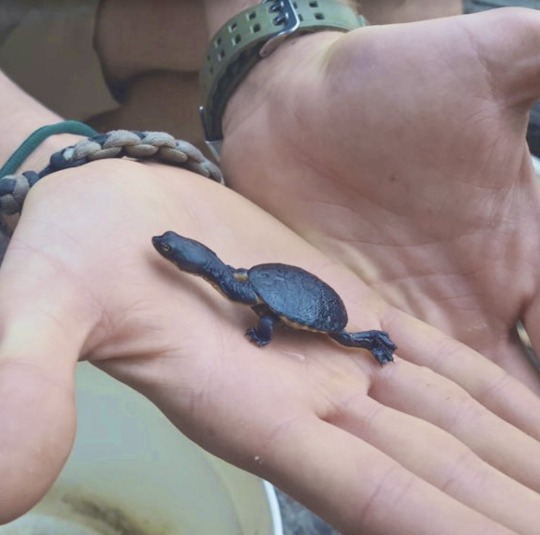
“[Friends of Lake Claremont] has transformed the area into a thriving ecosystem, re-establishing native habitats and fostering biodiversity. This year, 800 native seedlings (100 trees, 350 shrubs and 350 ground covers) have been planted on the northwestern buffer of Lake Claremont. Volunteers replaced a large Port Jackson fig (Ficus rubiginosa) affected by [beetle] infestation with native plants to enhance the local wildlife habitat, thereby benefiting insects, frogs, birds and brown bandicoots. […] Overall, the project contributes to the area’s function as a regional ecological corridor, linking inland bushlands, the Swan River and the Indian Ocean.”
6. Important habitat for fish in Heart of the Fraser now conserved

“British Columbia’s iconic salmon now have more protected spawning habitat in the lower Fraser River, thanks to the Nature Conservancy of Canada’s (NCC’s) conservation acquisition of Carey Island. […] Carey Island and its gravel channels offer calm and crucial spawning and rearing habitat for the river’s fish and aquatic species. […] The Pelólxw Tribe […is also] actively working to restore the resilience of aquatic habitat within this stretch of the Lower Fraser. NCC is exploring opportunities to collaborate with the Pelólxw Tribe in support of their vision for stewardship of the area, which prioritizes both ecological and cultural values.”
7. Prime editing efficiently corrects cystic fibrosis mutation in human lung cells
“[R]esearchers have developed a gene-editing approach that efficiently corrects the most common mutation that causes cystic fibrosis, found in 85 percent of patients. With further development, it could pave the way for treatments that are administered only once and have fewer side effects. The new method precisely and durably corrects the mutation in human lung cells, restoring cell function to levels similar to that of Trikafta [the standard treatment since 2019].”
8. Montana’s High Court Considers a Constitutional Right to a Stable Climate

“At issue was the appeal of a decision last year, when a Montana judge blocked a state law that prohibited agencies from considering climate impacts when deciding whether to approve fossil fuel projects such as new power plants, pipelines or mining. The ruling, by District Judge Kathy Seeley, was prompted by a lawsuit filed by 16 youths who argued that the law violated Montana’s constitutional right to a “clean and healthful environment.” It was the first ruling in the United States to effectively establish constitutional rights to a stable climate[….]”
9. The US is about to get its first solar-covered canal

“The first canal-based solar project in the U.S. is nearing completion on tribal lands south of Phoenix, Arizona. […] The long, narrow solar array design would snake along the line of the canal and tap into the local electrical distribution grid every 1,000 feet, or every one megawatt. […] “Canal solar allows for greater power production per land size, cleaner water, less power transmission losses, and significant reduction in evaporation[….]” Covering the entire 8,000 miles of canals and waterways managed by the Bureau of Reclamation with solar panels could generate over 25 gigawatts of renewable energy and reduce water evaporation by tens of billions of gallons[….]”
10. Camera traps offer glimpse of first beaver born in Northumberland for 400 years
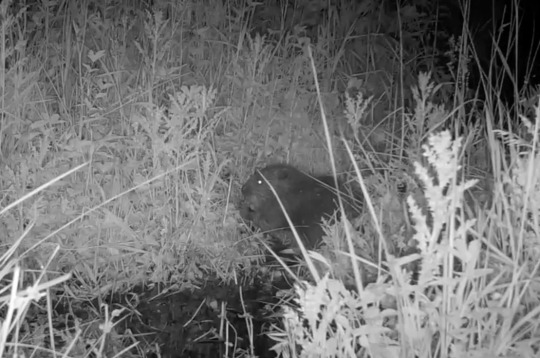
“"It’s such a relief that they have bred successfully and to see a new fluffy kit swimming with the family[….]” In just one year [since releasing the beavers], there has been a noticeable increase in resident trout, says the National Trust, along with more regular visits from kingfishers and grey herons. There are more insects at the site, too, thanks to the organic matter that builds up behind the dams, which in turn provides food for Daubenton’s bats. […] Beavers also play an important role in creating habitats that are more resilient to the effects of climate change[….]”
July 1-7 news here | (all credit for images and written material can be found at the source linked; I don’t claim credit for anything but curating.)
#hopepunk#good news#horse#zoo#nature#extinct species#sustainability#forest#children#disability#playground#disabled#wheelchair#diabetes#medicine#science#urban#biodiversity#ecosystem#fish#first nations#cystic fibrosis#gene editing#climate change#climate#youth#human rights#solar panels#solar energy#beaver
320 notes
·
View notes
Text
2023 Reading Log, pt 8
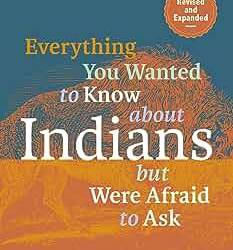
36. Everything You Wanted to Know About Indians but Were Afraid to Ask, Revised and Expanded Edition by Anton Truer. This book is written by an Ojibwe professor (as in, both that he’s Ojibwe and teaches Ojibwe language), and is aimed primarily at a novice, non-Native audience. Truer’s whole career is based on expanding education of Native languages, preserving endangered languages, and revitalizing tribal culture while simultaneously building bridges with mainstream American culture. It does a very good job of summarizing issues about land rights, sovereignty, history and civil rights about Native Americans. It’s written in an engaging style, and is doing good anti-racism work, I think. But it has issues, and the big one is the Culture chapter. The Culture chapter is written basically assuming that all Indian Country (his words) works the way that Ojibwe tribes and their neighbors do, with minor variations. Obviously, this is both an introductory book and one that needs to summarize an immensely diverse group of people, but I think the author does himself no favors by saying things like all Native American religions are monotheistic. So definitely take the cultural material with a grain of salt.
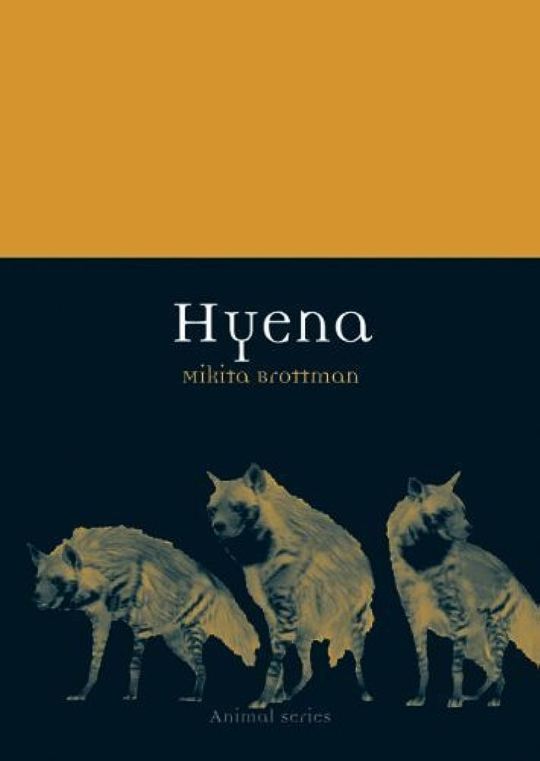
37. Hyena by Mikita Brottman. This book is part of the Animal series by Reaktion Books, little chapbook sized books about the natural and cultural history of some particular animal. This book focuses much more on the cultural than natural history, talking about how hyenas have been reviled by many cultures (including modern pop culture) and consistently confused with each other by early scientists. That bit, about the entangling of different hyenas, is the part that was the most novel and interesting to me, as I quite like the history of science. The book is well illustrated, with a variety of woodcuts and illustrations from vintage European books, as well as artifacts from people who live among hyenas, and photos of hyenas wild, in zoos and tamed by people. I did find it a weird oversight that, in a chapter that includes Magic the Gathering cards of hyenas and hyenas in World of Warcraft, that it didn’t talk about gnolls or anthropomorphic hyenas in fantasy fiction.

38. The Monster Overhaul by Skerples. This book is a monster book for fantasy RPGs, written for a generic OSR style game. It’s different in that it focuses on a relatively small number of monsters for its size, instead doubling down on plot hooks, descriptions and ways to otherwise bring creatures to life at the table. The gimmick? Random tables for everything, even the table of contents. The organization is somewhat intentionally bizarre, but the book is well indexed. It’s also highly readable for a book that is comprised mainly of tables. The Monster Overhaul is thoughtful about its uses for monsters, has clever takes on some D&D staples (like how manticores are all male and are the embodiment of male entitlement and bitterness, or how “brain eaters” are literally addicted to humanoid brains), and is very funny to boot. Highly recommended for anyone interested in fantasy RPGs, regardless of system.

39. Healing with Poisons by Yan Liu. This is an academic text discussing the development of Chinese medicine in the 3rd through 10th centuries. The focus is on du, roughly translated as “potency”, a force ascribed to medicinal ingredients that were generally toxic. The book talks about the philosophy of medicine in medieval China and how that philosophy changed between authors, how the government got more involved in standardizing medical texts, and how regional differences between practices and ingredients influenced that standardization. It also goes into a lot of detail about how various toxic minerals, particularly arsenates and mercury, were used to make “elixirs of life”, and how the fact that these often very clearly killed people was rationalized away for centuries before “internal alchemy” became more popular than “external alchemy”. There’s also a discussion of a royal scandal involving the court during the Sui dynasty being plagued by a cat demon!

40. Geopedia by Marcia Bjornerud. This is the best of the –pedia series I’ve read (sorry, Darren Naish!). It covers bits of geology, with a focus on explaining major earth formations and covering the history of science. As such, there’s a lot that I didn’t know that I learned from this book, especially about some of the also-ran hypotheses that were rejected when plate tectonics was understood to be the driving force behind most earth processes. It’s highly readable and does a very good job of drawing connections between bits of seemingly disparate information to explain how the Earth works. This book is a very good resource for people who know a bit about geology and want to learn more.
#reading log#geology#chinese history#traditional chinese medicine#monster book#hyena#native american
14 notes
·
View notes
Photo

Nandankanan Zoological Park…!! Nandankanan Zoological Park is one of the biggest and famous zoos in India. Located in Bhubaneswar, this zoo, unlike others in the country, has been built inside a natural forest, which is moist deciduous in nature and remains semi-ever green. The animals kept in this zoo get the feel of their natural surroundings and roam freely without any apprehensions. Nandankanan has the distinction of being the first zoo in the world to breed Melanistic and White tigers and the sole conservation breeding center for Indian Pangolins, across the globe. A member of the World Association of Zoos and Aquarium (WAZA) - the only one in the country - the Nandankanan zoo is also recognized by the Central Zoo Authority (CZA) for preservation of Indian pangolins, tigers and long billed vultures. It is the first zoo in the country to feature an open-top enclosure for leopards and also the first, where endangered Ratels were born in captivity. The zoo has large pools for housing Hippopotamus and Gharials, and has been a captive breeding center for the latter since 1980. The name ‘Nandankanan’ in the local language means ‘Garden of the Heavens’. Such is the importance and exclusivity of the zoo that the Indian Railways has named an express train after it called the Nandankanan Express while the Indian Postal Department has released a special cover featuring it. On a visit to the city of Bhubaneswar, an excursion to the Nandankanan Zoological Park and Botanical Garden is a must, especially for those tourists, who are traveling with their children. 🤳➡️ @sudhanya07 . . . . . #nandankanan #bhubaneswar #odisha #zoo #zoological #zoologicalpark #zoologicalgarden #orrisa #orissa #orissatourism #odishatourism #odishagram #india #rohitgpt009 #tourism #tourist #zoolovers #zoolove #zoolover #nature #animals #animal #animallovers #lion #tiger #deer #foetus (at Nandankanan Zoological Park) https://www.instagram.com/p/Cmfv2Qmv5r-/?igshid=NGJjMDIxMWI=
#nandankanan#bhubaneswar#odisha#zoo#zoological#zoologicalpark#zoologicalgarden#orrisa#orissa#orissatourism#odishatourism#odishagram#india#rohitgpt009#tourism#tourist#zoolovers#zoolove#zoolover#nature#animals#animal#animallovers#lion#tiger#deer#foetus
2 notes
·
View notes
Text
American Oz: The Lakota Ghost Dance and the Massacre at Wounded Knee
How the American drive to force Indian assimilation turned violent on the plains of South Dakota.
— April 16, 2021 | Louis S. Warren | From the Collection: Native Americans

Native Americans performing ritual Ghost Dance. One standing woman is wearing a white dress, a special costume for the ritual dance, 1890. Photo by James Mooney, an ethnologist with US Dept. of Interior. Alamy
Editor’s Note: When L. Frank Baum and other white settlers arrived in Aberdeen, South Dakota in the 1880s, they were entering land that had been part of the homeland of the Western Sioux or Lakota. On the Standing Rock and Pine Ridge reservations west of Aberdeen, conditions were dire for the over 10,000 Lakota living there. In the following excerpt from God’s Red Son: The Ghost Dance Religion and the Making of Modern America, Louis S. Warren recounts the Lakota struggle to resist assimilation and survive in the face of violent suppression from the administration of President Benjamin Harrison.
In the west, drought had baked the earth bare. Indian reservations occupied poor land that had little game and few wild plants of any use. In the withering heat, what grass was left by cattle and sheep (most of them owned by white ranchers) quickly shriveled. Scarce game vanished. By 1885, many Indians had turned their hand to farming, but in 1890 their crops wilted. Starvation, that old monster, circled the camps.
It was thus not surprising that some Indians had turned to a new faith. In doing so, Indian believers unwittingly launched upon a collision course with the anxious American public. What swept the West that summer was an evangelical revival that synthesized ancient Indian beliefs with new millenarian teaching. Strange stories made their way from neighbor to neighbor, from one people to the next, stories of distant laughter on the breeze, dead loved ones brought back to life, and an earth again made green and bountiful.
Bison hunting had ceased by the early 1880s, for the animals were nearly extinct. The only survivors of the great herds were living in Yellowstone National Park in Wyoming, on a few private ranches far to the south or in Canada, and in zoos and traveling Wild West shows. But in 1890, in the midst of the drought, a few of the shaggy beasts appeared suddenly on one of the Sioux reservations in South Dakota. Had the spirits returned their favor? How else could one explain this miraculous event?
Stories like these spread among friends and acquaintances, raising unanswerable questions and inspiring new faith. And all that fall, Indians danced. They danced from the deep Southwest to the Canadian border and into Alberta. They danced from the Sierra Nevada to eastern Oklahoma. They danced in southern Utah, and in Idaho. They danced in Arizona.
In Nevada, a thousand Shoshones danced all night, and as the eastern sky turned pale shouts rang out that the spirits of deceased loved ones were appearing among the faithful. A thousand voices shouted in unison, “Christ has come!,” and they fell to the ground, or perhaps to their knees, weeping and singing and utterly exhausted. Although many had dismissed the springtime talk of a messiah somewhere in the mountains of western Montana, the rumor seemed only to grow over time. From the Southwest to the Wind River Mountains of Wyoming and on into the plains of South Dakota, Indians spoke of a redeemer to the north.

Ghost Dance Drum by George Beaver, wood, rawhide and pigment, late 1890s, Fenimore Art Museum. Public Domain
By the fall of 1890, authorities who read the telegrams and heard the reports had become uneasy. Thirty Indian reservations were transfixed by the prophecies of the Messiah, but the teachings had a particularly enthusiastic following among the Lakota Sioux, also known as the Western Sioux. Because of the relatively recent history of US hostilities with these people—the notorious Sitting Bull was learning the new faith—it was there that government agents soon focused their attentions.
It is almost impossible to overstate how vehement officials and other Americans eventually became over the need to break up the dances. Of all the features of the new ritual that garnered commentary, the physical excitement of the dancers received the most attention. The central feature of the Ghost Dance everywhere was a ring of people holding hands and turning in a clockwise direction—“men, women, and children; the strong and the robust, the weak consumptive, and those near to death’s door,” as one observer described them. Lakotas had grafted onto the Ghost Dance some symbols of their primary religious ritual, the Sun Dance. Thus, Sioux believers felled a tree, often a young cottonwood, and re-erected it at the center of their dance circle. On it they hung offerings to the spirits, including colored ribbons and sometimes an American flag. Near the tree stood the holy men, supervising the event and assembling the believers, who began by taking a seat in the circle around the tree. There was a prayer, and sometimes a sacred potion was passed for participants to drink. Then dancers might together utter “a sort of plaintive cry, which is pretty well calculated to arrest the ear of the sympathetic.” Once these preliminaries were completed, the dancers rose and started singing—unaccompanied, without drums or other instruments—and the circle began to turn.
Astonished and disturbed by the enthusiasms of the ritual, some American witnesses were moved to dire warnings. One agent reported that the Indians favored “disobedience to all orders, and war if necessary to carry out their dance craze.” “The Indians are dancing in the snow and are wild and crazy,” hyperventilated the agent at Pine Ridge. Another denounced the actual dance as “exceedingly prejudicial” to the “physical welfare” of the Indians, who became exhausted by it. “I think, “the agent went on, “steps should be taken to stop it.” Fearful that unconscious women might be molested, one white witness at Pine Ridge claimed that women “fall senseless to the ground, throwing their clothes over their heads, and laying bare the most prominent part of their bodies, viz., ‘their butts’ and ‘things.’” Concluded still another, “The dance is indecent, demoralizing, and disgusting.”

Bird's-eye view of a large Lakota camp of tipis, horses, and wagons--probably on or near Pine Ridge Indian Reservation. Photographer John C. H. Gabriel, 1891. Library of Congress
For these observers, the dance was a physical manifestation of irrationality, a refusal to be governed in body or in spirit by the codes of Victorian decorum handed down from missionaries. In one sense, at least, this view was substantially correct. For the Lakota and for other Indians, however, the Ghost Dance was both strikingly new—even radical—and reassuringly familiar. Ghost Dancers were searching for a new dispensation, seeking to restore an intimacy with the Creator that seemed to have vanished. And for followers, the religion’s key attractions included the chance to worship in a form that reconstituted Indians as a community and expressed their history, families, and identity—in a word, their Indianness. The Ghost Dance invited believers, as one Sioux evangelist put it, to “be Indians” again.
The real "messiah craze" of 1890 was the fixation of Americans on Indian dancing and their relentless compulsion to stop it, and the root of that craze was this American passion for assimilation, which was, after all, every bit as millennial a notion as the Second Coming itself. What more utopian a dream could there be for a rapidly globalizing society riven by fractures of race, culture and class than that a day would come when differences between people had simply disappeared? So it was that, in a show of hostility to physical exaltation reminiscent of the Puritans, policymakers waged war on Indian dances. In 1882 US Secretary of the Interior Henry M. Teller issued new orders to suppress “heathenish dances, such as the sun dance, scalp dance, &c.,” in order to bring Indians into line with conventional Christian practice.
The situation was all the more frustrating because it should have been easy. Indians had practically no power. They held no citizenship and remained federal subjects unable to vote. With no political representatives, they depended on appointed officials—reservation supervisors known as “Indian agents”—for their very survival. Dawes and others believed that education, example, and compulsion could turn Indians into good citizens. If Congress would mandate (and Indians agents would follow) a stern policy of assimilation, surely it would “kill the Indian and save the man,” as one prominent assimilationist put it. Thus would Indians enter the fold of the civilized, pointing the way for millions of immigrants and African Americans and preparing the ground for that glorious day when all dark skins would somehow whiten and racial strife would vanish.

The Ghost dance by the Ogallala [sic] Sioux at Pine Ridge Agency, Frederic Remington, Pine Ridge, S. Dakota, 1890. Library of Congress
For Americans, then, the challenge of assimilation was the great social question whirling at the center of the Ghost Dance of 1890. A millennial enthusiasm for assimilating others, as well as a deep anxiety that they might refuse to be assimilated, explains much of what made the Ghost Dance so troubling. To most white Americans, the dance itself was proof that assimilation had failed to dampen the savage impulse and that America’s irresistible conquest might prove resistible after all. In this light, the dances in South Dakota were more than just dances, and more than another Indian uprising. For Americans, something more, much more, was on the line.
Still, well into the fall of 1890, Ghost dances were nothing more than a curiosity, titillating fare for newspaper readers in distant cities. Although the dances had increased in intensity early in the fall, officials on the scene were mostly unconcerned. As late as the first week of November, only one Indian agent in South Dakota had requested military intervention; the others believed that the dance would die out of its own accord. Most local newspapers carried little to no news of the Ghost Dance.
But on November 13, President Harrison ordered the army into the Sioux reservations to shore up beleaguered officials and prevent “any outbreak that may put in peril the lives and homes of the settlers of the adjacent states.” With one-third of the entire US Army descending on some of the most remote and impoverished communities in the United States, the “Ghost Dance War” quickly became the largest military campaign since Lee’s surrender at Appomattox.
The arrival of columns of soldiers panicked the Indians and, in conjuring the possibility of war, terrified many settlers, who until that moment had not felt threatened. After treating the Ghost Dance mostly as a curiosity, the press now sank to new lows, riveting a considerable portion of the nation’s 63 million people with stories about imminent “outbreaks” by bloodthirsty savages—never mind that fewer than a quarter of a million Indians remained in the United States, and only 18,000 of these were Lakota Sioux. Never mind that there were only about 4,200 Ghost Dancers, and that most of them were children, their mothers, and the very old. The New York Times quoted estimates of 15,000 “fighting Sioux,” and others picked up rumors of an impending Sioux “outbreak.” Some even reported that thousands of armed Indians had surrounded the reservation and killed settlers and soldiers.

Sitting Bull by D F Barry, 1883 Dakota Territory, Public Domain
In mid-December, James McLaughlin, the agent at Standing Rock Reservation (some 275 miles north of Wounded Knee), sent the Indian police to arrest Sitting Bull, the most renowned Lakota chief still living. McLaughlin had long harbored a personal grudge against Sitting Bull. Now, since Sitting Bull had allowed Ghost Dances to take place at his camp, McLaughlin hoped to exploit the Ghost Dance tumult to have him removed from the reservation. When the detachment arrived at Sitting Bull’s home at dawn on December 15 and took him into custody, however, some of Sitting Bull’s enraged followers opened fire, and in the conflagration that followed the police shot the famed chief in the head and chest. The killing of Sitting Bull sent waves of panic and fear across the reservation, and when Lakota Indians there and at other reservations heard the news, they began to crisscross the countryside looking for refuge from the troops.
So it was that on December 28 a starving band of Ghost Dancers who had fled their homes on Cheyenne River Reservation surrendered to Colonel James Forsyth’s Seventh Cavalry at Wounded Knee Creek. The next morning troops upended Sioux lodges in a hunt for weapons. Two soldiers were attempting to seize a weapon from a Lakota man when it discharged. No one was hurt, but it did not matter. The ranks of soldiers opened fire. With four rapid-fire Hotchkiss guns on the edges of the ravine, Custer’s old regiment loosed an exploding shell nearly every second from each of the big guns—and a fusillade of rifle and pistol fire besides—into the mass of mostly unarmed villagers below. Indian men who were not instantly cut down did their best to fend off the troops with a few guns, some knives, rocks, and their bare hands as the ranks of women, children and old people fled up the creek.
Among the Sioux men at Wounded Knee were a handful of the continent’s most experienced close-range fighters, and when the conflict was over, the army did not emerge unscathed. The Seventh left the field with dozens of wounded, and thirty troopers died. The army took thirty-eight wounded Indians with them but left the Indian dead and more of their wounded to the mercy of the Dakota sky. As night fell, winter descended in all its high-country fury. Temperatures dropped far below freezing, and a fierce blizzard howled in from the north. Corpses turned to ice. When soldiers and a burial party returned three days later, they found several wounded Lakotas yet clinging to life and some surviving infants in the arms of their dead mothers. All but one of these babies and most of the others soon succumbed.
Soldiers heaped wagons with the Indian dead, who looked eerily like the haunting plaster casts of the Pompeii victims of Mount Vesuvius, some having frozen in the grotesque positions in which they had hit the ground. Others were curled up or horribly twisted, their hands clawing at the air and mouths agape, each a memorial to the agony of open wounds, smothering cold and the relentless triumph of death. A photographer arrived to take pictures (which immediately became a popular line of postcards).

Big Foot's camp three weeks after the Wounded Knee Massacre with bodies of several Lakota Sioux people wrapped in blankets in the foreground and U.S. soldiers in the background, Dec. 29, 1890. Library of Congress
The gravediggers lowered the bodies of 84 men, 44 women and 18 children into the ground. More had died, but many had been taken by kin or managed to leave the field before dying, perhaps in another camp, or alone on the darkling plain. We can look at old photographs, read crumpled letters and scan columns of crumbling newspaper, but death is final and pitiless, and its tracks soon vanish. We cannot account for all who were killed at Wounded Knee.
Religion is an affair of the heart, but it offers relief and guidance for people living in a hard-edged world. Indians became Ghost Dancers partly in response to changing material conditions that had created an existential crisis. Much of the religion’s allure came from how it addressed a radically shifting material world and helped Indians cope with the Industrial Revolution and its accompanying juggernaut of modernity, the rise of corporate structures to economic dominance in the United States, and the expanding bureaucracy of the state and modern education. The Ghost Dance served the needs of Indians hoping to adjust to life under industrial capitalism in a nation where literacy was key to negotiating courtrooms and the government offices that administered so much of Indian life.
In other words, in the aftermath of American invasion, the Ghost Dance helped believers find ways to negotiate and assert new dimensions of control not only over their own spiritual lives but also over their governance. In this sense, the massacre at Wounded Knee marks a brutal suppression not of naive, primitive Indians but of pragmatic people who sought a peaceful way forward into the twentieth century.
It is testament to its modernity that the religion was not so easily killed. The promise of the Ghost Dance was so great that Indian people carried on its devotions long after Wounded Knee. It survived on the Southern Plains and in Canada well into the twentieth century. In many places, it made lasting contributions to Indian ritual, some of which survive to the present day.
— Louis S. Warren is W. Turrentine Jackson Professor of Western U.S. History at the University of California, Davis, where he teaches the history of the American West, California history, environmental history, and U.S. history. His most recent book, God’s Red Son: The Ghost Dance Religion and the Making of Modern America. His other books include The Hunter’s Game: Poachers and Conservationists in Twentieth-Century America and Buffalo Bill’s America: William Cody and the Wild West Show.
3 notes
·
View notes
Text
Field Trip to Milwaukee County Zoo (Milwaukee, WI)
Hiya! This is another self-insert imagine fic where the reader is an age regresser and the author is their caregiver. All pictures were taken by me. This one’s a little less detailed than the Field Museum fic, but it also has more elements to it. Feel free to tell me which style you prefer! 😁 Under the cut ‘cause it’s long. Hope you enjoy!

Are you excited, sweetheart? I am too. We haven’t been to the zoo in a while, have we? Now remember, since it’s Halloween, there might be some spooky decorations. No, I don’t think there’s anything too scary - but if something does scare you, you can tell me, okay? Alright, let’s go in!

Oh, penguins! Now, why are they sitting there on the rocks? If I was a penguin I’d spend all my time swimming!

Ha, look at that! The aliens are wearing disguises!

My goodness, the trees are beautiful, aren’t they? I love autumn. What’s your favorite season, sweetheart?
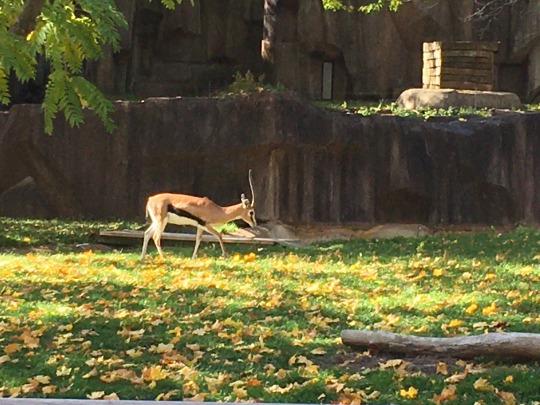
Ooh, a Thomson’s Gazelle! I wonder if Thomson knows the zoo has his gazelle here?*
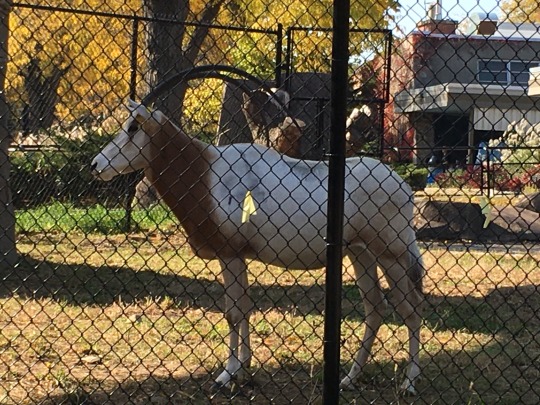
This guy has a long name. Think you can read it, sweetheart? “Scimitar-Horned Oryx”. Phew, what a mouthful! But he looks pretty cool, doesn’t he?

Look! The ostrich is coming over to meet you! I bet she’s never seen such a cute kiddo before.
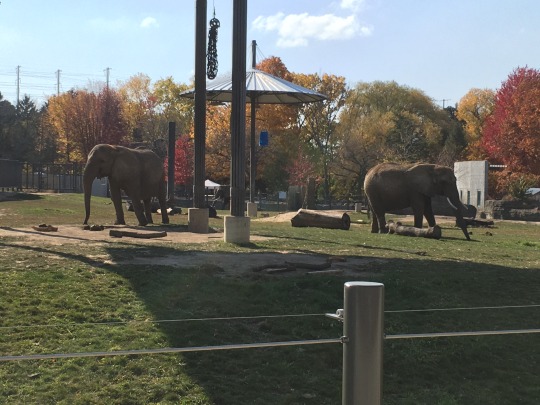
Wow! The elephants are so big! They must be African elephants because- That’s right! Indian elephants have smaller ears. How’d you get so smart?
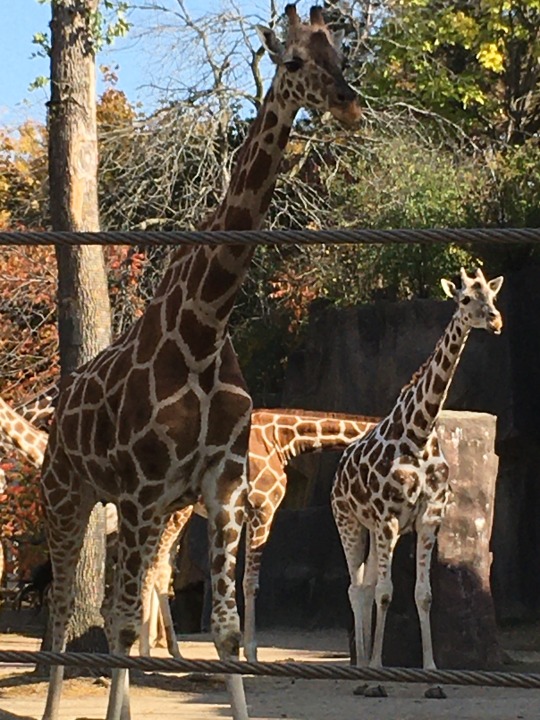
Aw, the giraffe has a baby! You’re right, it seems like the mama is taking good care of her baby. And, just as important…
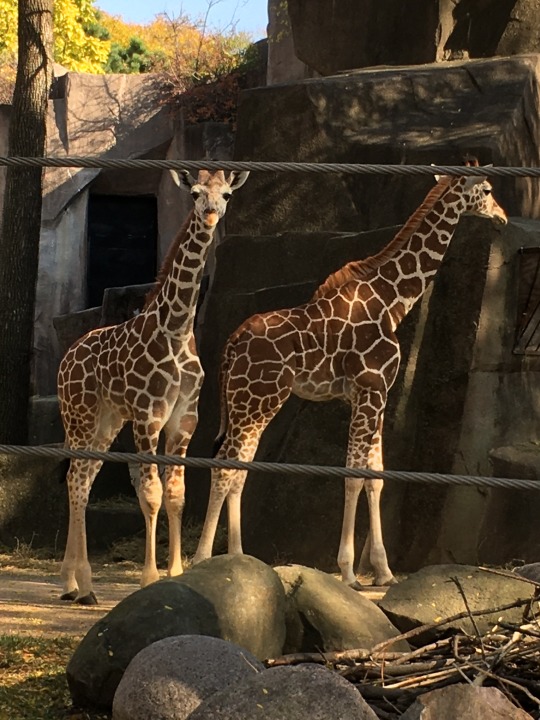
… the baby has a friend to play with!
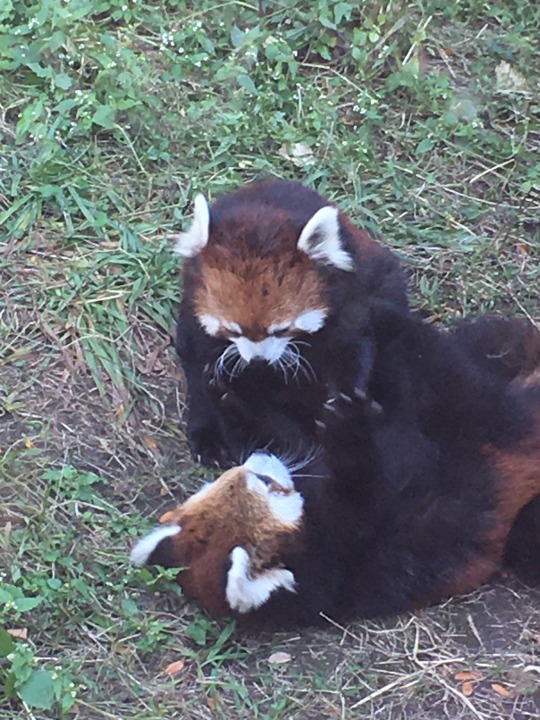
You’re right! They’re red pandas, just like Meilin! Oh, don’t worry, they’re not really fighting. See how careful they are not to bite, or swat too hard? They just like to wrestle sometimes.

Hello, tiger! Look how close he is… I know, he’s like a really big kitty!
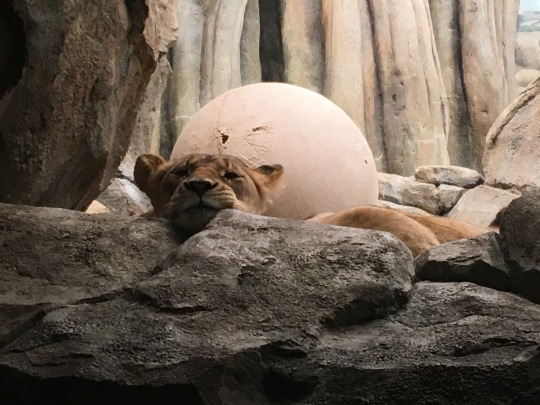
Aw, the lion is sleeping! You’re right, we shouldn’t wake her…
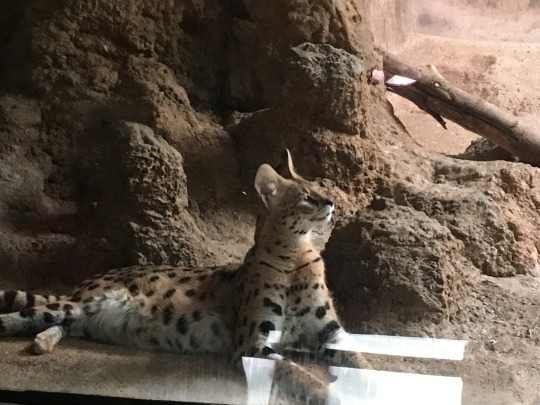
Ooh, a serval! They can jump super-duper high! How high can you jump, sweetheart?
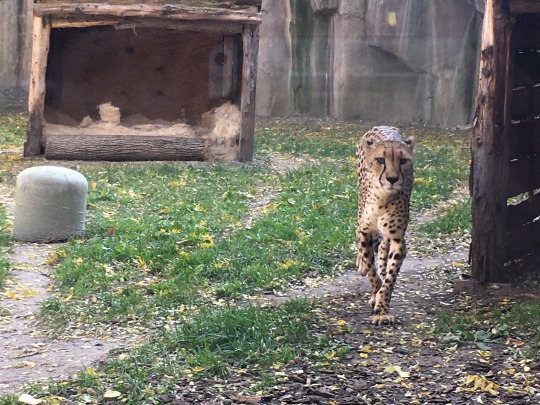
Hi cheetah! Y’know, sometimes cheetahs get really nervous, so the zookeepers find doggies to be their friends and help them feel better.
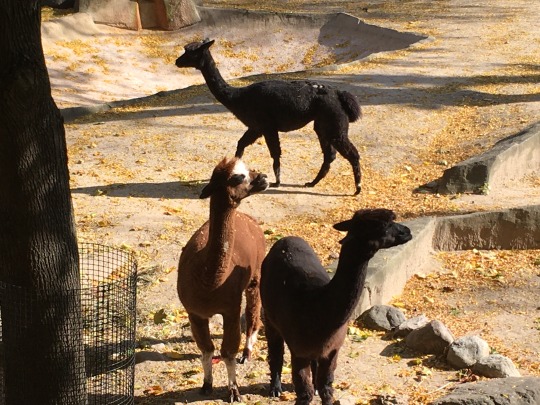
Look how fluffy the alpacas are! Yeah, I bet they feel really soft. They come from South America, just like…

… tapirs! Isn’t he cool? He looks like a pig, and he’s got a nose that can move around like an elephant, but you know what? He’s actually related to horses and rhinos! I know, he doesn’t really look like them… But you don’t need to be exactly the same to be family.

Oh, hello pretty peacock! He has so many beautiful colors!
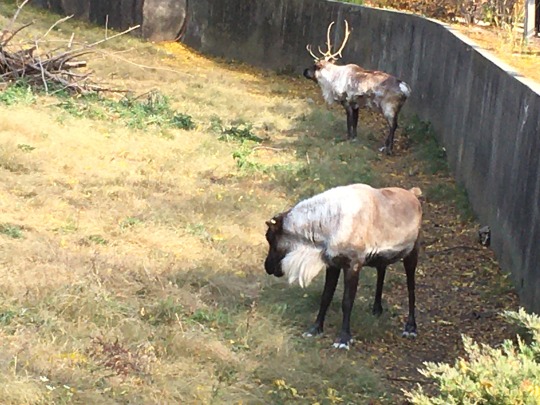
They do look like reindeer, don’t they? But these are actually caribou! I think they’re related to reindeer, though… Hm, maybe they know Santa!
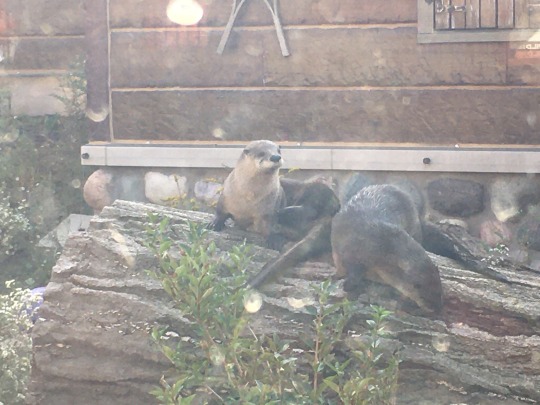
Oooh, otters! Oh, yes, sweetheart, I like otters very much! They’re so cute, and so silly! Kinda like you, hm?
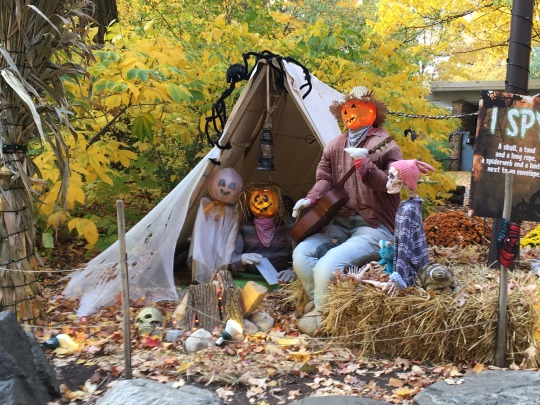
Oh, look at this creepy campground! Ha, I love decorations like this… Someone took all these pieces and imagined them camping and then put them together. Just like when we play pretend with your toys.
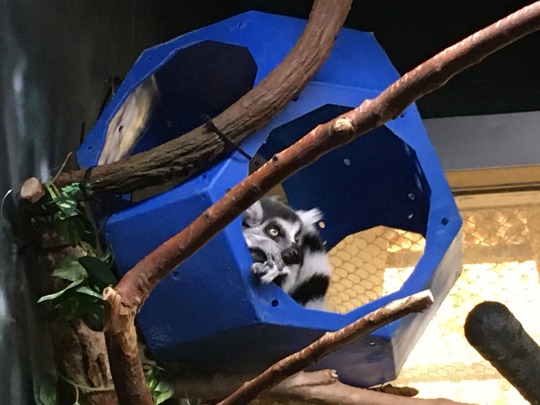
Haha, look at that lemur! I think he needs a nap.

Oh, don’t be scared, sweetie. I know it’s dark, but these animals only come out at night. Too much light would make the bats sleepy, and then we wouldn’t get to see them.
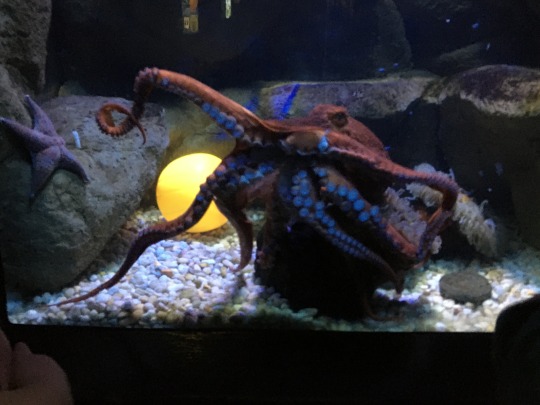
Wow, the octopus really wants to play with you!

Look at this silly snake! Ooh, he just flicked his tongue - he’s sniffing us!

Do you like fish, sweetie? They don’t do very much, but they are nice to look at.

Aw, I love turtles! It looks like he’s smiling at us.
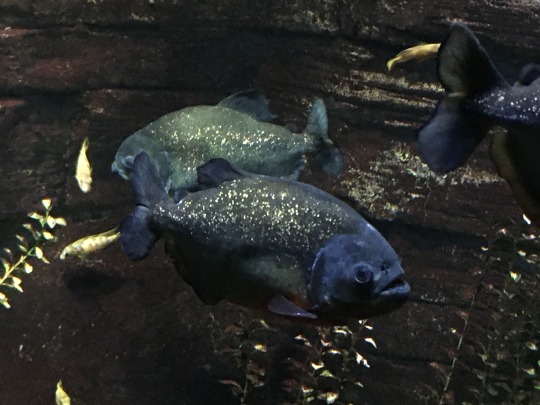
Ooh, piranhas! Yes, they can be very dangerous… but they’re kinda pretty too! See how sparkly they are?
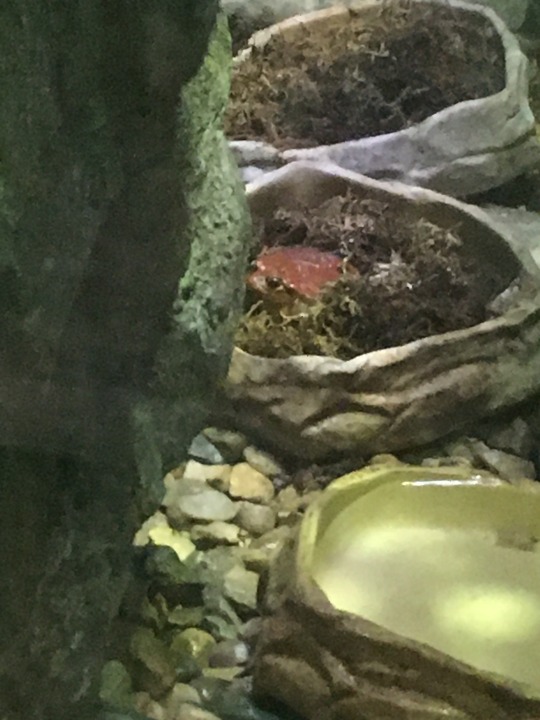
Ooh, look at the little tomato frog! You’re right, he wouldn’t be very nice to find in your salad.
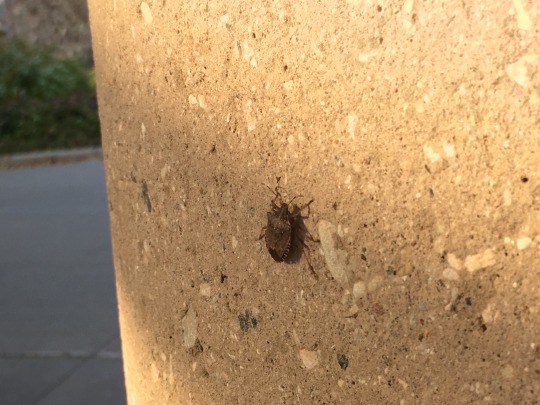
Alright, it’s time to go get some dinner… Sweetheart? What are you…? Ooh, hi there little guy! Ha, guess we don’t need to go to the zoo to see cool creatures, do we? But we can still come back sometime, sweetie.
~🐧~🍁~👽~🐘~🦒~🐅~🦁~🐆~🦙~🦚~🦦~🏕~🦇~🐙~🐍~🐟~🐢~🐸~🪲~
*I made this joke at the zoo and no one laughed, but darn it, I think it’s funny! 😝
#Eflen Field Trips#Eflen writes#age regression field trip#agere field trip#age regression Milwaukee county zoo#agere Milwaukee county zoo#age regression zoo#agere zoo#age regression imagine#age regression fic#age regression#sfw age regression#agere#sfw agere
4 notes
·
View notes
Text
Holidays 4.8
Holidays
Aerosol Day
All is Ours Day
Baghdad Liberation Day (Kurdistan)
Bloating Prevention Day
Colorism Awareness Day
Counter Stool Memorial Day
Cushing’s Disease Awareness Day
Cuti Bersama (Indonesia)
DAB Day (Draw A Bird Day)
Day of Military Commissariat Employees (Belarus)
Day of Silence
Day of Valor (Araw ng Kagtingan; Philippines)
Dog Farting Awareness Day
Draw a Picture of a Bird Day
Drug Control Authority Workers’ Day (Kyrgyzstan)
Economist Day (Tajikistan)
Geranium Day (England)
Ghodejatra (Nepal)
Grand Ivy Day
Grand National Ladies Day (UK)
Ground Ivy Day
Hammerin’ Hank Day
International Bird Day
International Day of Pink
International Feng Shui Awareness Day
International Pageant Day
International Romani Day (a.k.a. International Day of the Roma)
Ja Morant Day (South Carolina)
Martyrs’ Day (Tunisia)
Ministry of Defense Day (Thailand)
More Cowbell Day
Mule Day
National Animation Day (Russia)
National Arcade Day
National Banjo Day
National Best in the World Day
National Catch and Release Day
National Dog Fighting Awareness Day
National Idiot Day
National Plitvice Lakes Day (Croatia)
Peanuts-Kids-Baseball Day
Polling Day Eve (Samoa)
Pygmy Hippo Day
Radish Day (French Republic)
Rex Manning Day (in “Empire Records”)
Right to Read Day
Rumenians’ Independence Day (Sweden)
Sealing the Frost (Cuchumatan Indians; Guatemala)
Shiatsu Day
Shiba Inu Day (Japan)
Step into the Spotlight! Day
Trading Cards for Grown-Ups Day
Tutor Appreciation Day
Twin Peaks Day
World Mixed Martial Arts Day
World Neurosurgeon’s Day
Zoo Lovers' Day
Food & Drink Celebrations
Milk in Glass Bottles Day
National Empañada Day
2nd Monday in April
Global Day of Action on Military Spending [2nd Monday]
National Lineman Appreciation Day [2nd Monday]
Weekly Holidays beginning April 8 (2nd Week)
Ora;, Head and Neck Cancer Awareness Week [thru 4.14]
Take Your Poet to School Week [thru 4.12 from 1st Monday]
Independence & Related Days
Australis (a.k.a. Grand Duchy of Australis; Declared; 2020) [unrecognized]
Rumenians' Independence Day (Romernas Nationaldag; Sweden)
Festivals Beginning April 8, 2024
Children’ Book Fair (Bologna, Italy) [thru 4.11]
Electric Mountain Festival (Solden, Austria) [thru 4.12]
NFRA Executive Conference (Tempe, Arizona) [thru 4.10]
Seatrade Cruise Global (Miami, Florida) [thru 4.11]
Feast Days
Ædesius (Christian; Martyr)
Allen Butler Talcott (Artology)
Anne Ayres (Episcopal Church (USA))
Apollonius (Positivist; Saint)
B. Albert, Patriarch of Jerusalem (Christian; Saint)
Barbara Kingsolver (Writerism)
Buddha's Birthday (Mahāyāna Buddhists; Japan)
Constantina (Christian; Saint)
Cornelius de Heem (Artology)
Day of Amon-Ra (Pagan)
Dionysius of Corinth (Christian; Saint)
Feast of the Hummingbird (Aztec)
Feast of the Three Days of the Writing of the Book of the Law begins (Thelema)
Freedom of Religion Day (Everyday Wicca)
Geronimo Day (Church of the SubGenius; Saint)
Hana Matsuri (Flower Festival on Buddha’s Birthday; Japan)
Juan van der Hamen (Artology)
Julie Billiart of Namur (Christian; Saint)
Kanbutsu-e (Buddha’s Birthday; Japan)
Kiki the Rattlesnake (Muppetism)
Lazarus Saturday (Orthodox Christian)
Nuzzle Quran (Malaysia)
Odd Nerdrum (Artology)
Our Lady of Good Counsel (Christian)
Perpetuus of Tours (Christian; Saint)
Prayer for Clarity Day (Starza Pagan Book of Days)
Red Wine Day (Pastafarian)
Walter of Pontoise (Christian; Saint)
William Augustus Muhlenberg (Episcopal Church (USA))
Zoo Day (Pastafarian)
Lucky & Unlucky Days
Nēmontēmi, Day 4 (of 5) [Aztec unlucky or fasting days, taking place between 4.5-4.18]
Sensho (先勝 Japan) [Good luck in the morning, bad luck in the afternoon.]
Unlucky Day (Grafton’s Manual of 1565) [19 of 60]
Premieres
All the Old Knives (Film; 2022)
American: The Bill Hicks Story (Documentary Film; 2011)
The Apocrypha (Religious Text received as Canonical by Catholic Church; 1546)
Bars and Stripes Forever (WB MM Cartoon; 1939)
The Boss (Film; 2016)
Box Car Bandit (Woody Woodpecker Cartoon; 1957)
The Century, by Peter Jennings and Todd Brewster (Book; 1999)
The Clash, by The Clash (Album; 1977)
David and Goliath, by Malcolm Gladwell (Book; 2014)
Destitively Bonnaroo, by Dr. John (Album; 1974)
Father Noah’s Ark (Disney Silly Symphony Cartoon; 1933)
Fever Pitch (Film; 2005)
The Fireman (Oswald the Lucky Rabbit Cartoon; 1931)
From Russia, with Love, by Ian Fleming (Novel; 1957) [James Bond #5]
The Gambler (TV movie; 1980)
Hanna (Film; 2011)
Have Gun, Can’t Travel (Woody Woodpecker Cartoon; 1967)
Inspector George Gently (UK TV Series; 2007)
Jerry the Lion (Tom & Jerry Cartoon; 1950)
Just Dance, by Lady Gaga (Song; 2008)
Killing Eve (TV Series; 2018)
Kingdom (BBC TV Series; 2007)
La Gioconda, by Amiliare Ponchielli (Opera; 1876)
The Little Engine That Could, by Watty Piper (Children’s Book; 1930)
Lucky Star (Anime TV Series; 2007)
The Mansion Cat (Tom & Jerry Cartoon; 2001)
Miss Lonelyhearts, by Nathanael West (Novella; 1933)
Mr. Right (Film; 2016)
On the Heights of Despair, by Emil M. Cioran (Philosophical Book; 1934)
The Organ Grinder (WB MM Cartoon; 1933)
Sea Salts (Disney Cartoon; 1949)
The $64,000 Question (Radio Quiz Show; 1955)
Smash by The Offspring (Album; 1994)
The Smurfs Springtime Special (Hanna-Barbera Animated TV Special; 1982)
Soul Surfer (Film; 2011)
Toys in the Attic, by Aerosmith (Album; 1975)
The Trouble With Being Born, by Emil M. Cioran (Philosophy Book; 1973)
Twin Peaks (TV Series; 1990)
The Unusuals (TV Series; 2009)
Von Drake in Spain (Disney Animated TV Special; 1962)
Where Did Our Love Go, recorded by The Supremes (Song; 1964)
Ye Olden Days (Disney Cartoon; 1933)
Today’s Name Days
Beate, Rose-Marie, Walter (Austria)
Lazar, Lazo (Bulgaria)
Diogen, Dionizije, Klement, Timotej (Croatia)
Ema, Emanuel (Czech Republic)
Janus (Denmark)
Julia, Juuli, Juulika, Lia, Liana, Liane (Estonia)
Suoma, Suometar (Finland)
Julie (France)
Beate, Rose-Marie, Walter (Germany)
Lazaros (Greece)
Dénes (Hungary)
Alberto, Dionigi, Walter (Italy)
Dana, Danute, Dziedra, Edgars, Žanete (Latvia)
Dionizas, Girtautas, Julija, Skirgailė (Lithuania)
Asle, Atle (Norway)
Apolinary, Cezary, Cezaryna, Dionizy, Gawryła, January, Radosław, Sieciesława (Poland)
Agav, Irodion, Lazar, Ruf (Romania)
Alla, Anna (Russia)
Albert (Slovakia)
Amancio, Dionisio, Julia (Spain)
Hemming, Nadja, Tanja (Sweden)
Gillian, Jill, Jillian, Jolyon, Julia, Julian, Juliana, Julianna, Julianne, Julie, Julien, Juliet, Juliette, Julio, Julissa, Julius (USA)
Today is Also…
Day of Year: Day 99 of 2024; 267 days remaining in the year
ISO: Day 1 of week 15 of 2024
Celtic Tree Calendar: Fearn (Alder) [Day 23 of 28]
Chinese: Month 2 (Ding-Mao), Day 30 (Ren-Yin)
Chinese Year of the: Dragon 4722 (until January 29, 2025) [Wu-Chen]
Hebrew: 29 Adair II 5784
Islamic: 29 Ramadan 1445
J Cal: 9 Cyan; Twosday [9 of 30]
Julian: 26 March 2024
Moon: 0%: New Moon
Positivist: 15 Archimedes (4th Month) [Eudoxus]
Runic Half Month: Ehwaz (Horse) [Day 14 of 15]
Season: Spring (Day 21 of 92)
Week: 2nd Week of April
Zodiac: Aries (Day 19 of 31)
0 notes
Text
Holidays 4.8
Holidays
Aerosol Day
All is Ours Day
Baghdad Liberation Day (Kurdistan)
Bloating Prevention Day
Colorism Awareness Day
Counter Stool Memorial Day
Cushing’s Disease Awareness Day
Cuti Bersama (Indonesia)
DAB Day (Draw A Bird Day)
Day of Military Commissariat Employees (Belarus)
Day of Silence
Day of Valor (Araw ng Kagtingan; Philippines)
Dog Farting Awareness Day
Draw a Picture of a Bird Day
Drug Control Authority Workers’ Day (Kyrgyzstan)
Economist Day (Tajikistan)
Geranium Day (England)
Ghodejatra (Nepal)
Grand Ivy Day
Grand National Ladies Day (UK)
Ground Ivy Day
Hammerin’ Hank Day
International Bird Day
International Day of Pink
International Feng Shui Awareness Day
International Pageant Day
International Romani Day (a.k.a. International Day of the Roma)
Ja Morant Day (South Carolina)
Martyrs’ Day (Tunisia)
Ministry of Defense Day (Thailand)
More Cowbell Day
Mule Day
National Animation Day (Russia)
National Arcade Day
National Banjo Day
National Best in the World Day
National Catch and Release Day
National Dog Fighting Awareness Day
National Idiot Day
National Plitvice Lakes Day (Croatia)
Peanuts-Kids-Baseball Day
Polling Day Eve (Samoa)
Pygmy Hippo Day
Radish Day (French Republic)
Rex Manning Day (in “Empire Records”)
Right to Read Day
Rumenians’ Independence Day (Sweden)
Sealing the Frost (Cuchumatan Indians; Guatemala)
Shiatsu Day
Shiba Inu Day (Japan)
Step into the Spotlight! Day
Trading Cards for Grown-Ups Day
Tutor Appreciation Day
Twin Peaks Day
World Mixed Martial Arts Day
World Neurosurgeon’s Day
Zoo Lovers' Day
Food & Drink Celebrations
Milk in Glass Bottles Day
National Empañada Day
2nd Monday in April
Global Day of Action on Military Spending [2nd Monday]
National Lineman Appreciation Day [2nd Monday]
Weekly Holidays beginning April 8 (2nd Week)
Ora;, Head and Neck Cancer Awareness Week [thru 4.14]
Take Your Poet to School Week [thru 4.12 from 1st Monday]
Independence & Related Days
Australis (a.k.a. Grand Duchy of Australis; Declared; 2020) [unrecognized]
Rumenians' Independence Day (Romernas Nationaldag; Sweden)
Festivals Beginning April 8, 2024
Children’ Book Fair (Bologna, Italy) [thru 4.11]
Electric Mountain Festival (Solden, Austria) [thru 4.12]
NFRA Executive Conference (Tempe, Arizona) [thru 4.10]
Seatrade Cruise Global (Miami, Florida) [thru 4.11]
Feast Days
Ædesius (Christian; Martyr)
Allen Butler Talcott (Artology)
Anne Ayres (Episcopal Church (USA))
Apollonius (Positivist; Saint)
B. Albert, Patriarch of Jerusalem (Christian; Saint)
Barbara Kingsolver (Writerism)
Buddha's Birthday (Mahāyāna Buddhists; Japan)
Constantina (Christian; Saint)
Cornelius de Heem (Artology)
Day of Amon-Ra (Pagan)
Dionysius of Corinth (Christian; Saint)
Feast of the Hummingbird (Aztec)
Feast of the Three Days of the Writing of the Book of the Law begins (Thelema)
Freedom of Religion Day (Everyday Wicca)
Geronimo Day (Church of the SubGenius; Saint)
Hana Matsuri (Flower Festival on Buddha’s Birthday; Japan)
Juan van der Hamen (Artology)
Julie Billiart of Namur (Christian; Saint)
Kanbutsu-e (Buddha’s Birthday; Japan)
Kiki the Rattlesnake (Muppetism)
Lazarus Saturday (Orthodox Christian)
Nuzzle Quran (Malaysia)
Odd Nerdrum (Artology)
Our Lady of Good Counsel (Christian)
Perpetuus of Tours (Christian; Saint)
Prayer for Clarity Day (Starza Pagan Book of Days)
Red Wine Day (Pastafarian)
Walter of Pontoise (Christian; Saint)
William Augustus Muhlenberg (Episcopal Church (USA))
Zoo Day (Pastafarian)
Lucky & Unlucky Days
Nēmontēmi, Day 4 (of 5) [Aztec unlucky or fasting days, taking place between 4.5-4.18]
Sensho (先勝 Japan) [Good luck in the morning, bad luck in the afternoon.]
Unlucky Day (Grafton’s Manual of 1565) [19 of 60]
Premieres
All the Old Knives (Film; 2022)
American: The Bill Hicks Story (Documentary Film; 2011)
The Apocrypha (Religious Text received as Canonical by Catholic Church; 1546)
Bars and Stripes Forever (WB MM Cartoon; 1939)
The Boss (Film; 2016)
Box Car Bandit (Woody Woodpecker Cartoon; 1957)
The Century, by Peter Jennings and Todd Brewster (Book; 1999)
The Clash, by The Clash (Album; 1977)
David and Goliath, by Malcolm Gladwell (Book; 2014)
Destitively Bonnaroo, by Dr. John (Album; 1974)
Father Noah’s Ark (Disney Silly Symphony Cartoon; 1933)
Fever Pitch (Film; 2005)
The Fireman (Oswald the Lucky Rabbit Cartoon; 1931)
From Russia, with Love, by Ian Fleming (Novel; 1957) [James Bond #5]
The Gambler (TV movie; 1980)
Hanna (Film; 2011)
Have Gun, Can’t Travel (Woody Woodpecker Cartoon; 1967)
Inspector George Gently (UK TV Series; 2007)
Jerry the Lion (Tom & Jerry Cartoon; 1950)
Just Dance, by Lady Gaga (Song; 2008)
Killing Eve (TV Series; 2018)
Kingdom (BBC TV Series; 2007)
La Gioconda, by Amiliare Ponchielli (Opera; 1876)
The Little Engine That Could, by Watty Piper (Children’s Book; 1930)
Lucky Star (Anime TV Series; 2007)
The Mansion Cat (Tom & Jerry Cartoon; 2001)
Miss Lonelyhearts, by Nathanael West (Novella; 1933)
Mr. Right (Film; 2016)
On the Heights of Despair, by Emil M. Cioran (Philosophical Book; 1934)
The Organ Grinder (WB MM Cartoon; 1933)
Sea Salts (Disney Cartoon; 1949)
The $64,000 Question (Radio Quiz Show; 1955)
Smash by The Offspring (Album; 1994)
The Smurfs Springtime Special (Hanna-Barbera Animated TV Special; 1982)
Soul Surfer (Film; 2011)
Toys in the Attic, by Aerosmith (Album; 1975)
The Trouble With Being Born, by Emil M. Cioran (Philosophy Book; 1973)
Twin Peaks (TV Series; 1990)
The Unusuals (TV Series; 2009)
Von Drake in Spain (Disney Animated TV Special; 1962)
Where Did Our Love Go, recorded by The Supremes (Song; 1964)
Ye Olden Days (Disney Cartoon; 1933)
Today’s Name Days
Beate, Rose-Marie, Walter (Austria)
Lazar, Lazo (Bulgaria)
Diogen, Dionizije, Klement, Timotej (Croatia)
Ema, Emanuel (Czech Republic)
Janus (Denmark)
Julia, Juuli, Juulika, Lia, Liana, Liane (Estonia)
Suoma, Suometar (Finland)
Julie (France)
Beate, Rose-Marie, Walter (Germany)
Lazaros (Greece)
Dénes (Hungary)
Alberto, Dionigi, Walter (Italy)
Dana, Danute, Dziedra, Edgars, Žanete (Latvia)
Dionizas, Girtautas, Julija, Skirgailė (Lithuania)
Asle, Atle (Norway)
Apolinary, Cezary, Cezaryna, Dionizy, Gawryła, January, Radosław, Sieciesława (Poland)
Agav, Irodion, Lazar, Ruf (Romania)
Alla, Anna (Russia)
Albert (Slovakia)
Amancio, Dionisio, Julia (Spain)
Hemming, Nadja, Tanja (Sweden)
Gillian, Jill, Jillian, Jolyon, Julia, Julian, Juliana, Julianna, Julianne, Julie, Julien, Juliet, Juliette, Julio, Julissa, Julius (USA)
Today is Also…
Day of Year: Day 99 of 2024; 267 days remaining in the year
ISO: Day 1 of week 15 of 2024
Celtic Tree Calendar: Fearn (Alder) [Day 23 of 28]
Chinese: Month 2 (Ding-Mao), Day 30 (Ren-Yin)
Chinese Year of the: Dragon 4722 (until January 29, 2025) [Wu-Chen]
Hebrew: 29 Adair II 5784
Islamic: 29 Ramadan 1445
J Cal: 9 Cyan; Twosday [9 of 30]
Julian: 26 March 2024
Moon: 0%: New Moon
Positivist: 15 Archimedes (4th Month) [Eudoxus]
Runic Half Month: Ehwaz (Horse) [Day 14 of 15]
Season: Spring (Day 21 of 92)
Week: 2nd Week of April
Zodiac: Aries (Day 19 of 31)
0 notes
Text
Unveiling Ambala's Hidden Gems, History, and Thrills!

Ditch the Taj Mahal and Golden Temple crowds and dive into Ambala, India, tourist attractions. Colonial bungalows whisper tales in the cantonment, ancient temples echo with devotion, and vibrant bazaars burst where you can buy all those beautiful patiyala suits, eat authentic punjabi food, and quench your thirst with ambala whiskey. Beyond the usual tourist trail, Ambala offers wildlife encounters at Chhatbir Zoo, serene gardens in Pinjore, and the soulful chants of Anarkali Darbar Sahib. So, pack your bags, lace up your shoes, and discover the unexpected beauty of Ambala. From history buffs to adventure seekers, this Indian city promises an unforgettable experience. Don't wait; Ambala awaits!
History First!
The city is divided into two parts: Ambala Cantonment and Ambala City, each offering a unique glimpse into India's past. Ambala Cantonment, established during the British era, still retains its colonial charm with well-preserved architecture and wide avenues. The old bazaars in Ambala City exude an ancient aura, showcasing the city's deep-rooted connection to Indian history. Stroll Ambala Cantonment's quaint lanes, dive into history at the ancient Shiv Mandir and Kali Devi Temple, then escape to Pinjore Gardens' Mughal magic. Cross the city divide to Ambala City, where bustling bazaars burst with life and the iconic railway station's arches tell tales of a bygone era.
Spots You Can't Miss!
For a serene spiritual experience, the Badshahi Bagh Gurudwara stands as a testament to religious harmony amidst tranquil surroundings. Then there is Rani Ka Talab, a historic tank enveloped in lush greenery that offers a peaceful escape from urban chaos. For devotees seeking solace, the Bhawani Amba Temple, dedicated to the goddess Bhawani Amba, is a haven known for intricate carvings and a deeply spiritual ambiance.
Hidden Gems!
Escape the mainstream, explore Ambala's untrodden paths, and discover its captivating whispers. Seek solace in Sheikh Chilli's Tomb, a kaleidoscope of vibrant tiles and local lore. Gurudwara Manji Sahib, nestled away from the tourist mainstream, presents a serene haven for worship. Then you can pay a visit to the serene Anarkali Darbar Sahib, where communal meals and peaceful chants nourish both body and soul. For nature lovers, the Herbal Garden promises a fragrant wonderland, while the tranquil banks of the Ghaggar River offer a haven for birdwatchers.
Chhatbir Zoo: A Wildlife Extravaganza
No trip to Ambala is complete without a visit to the Chhatbir Zoo. For nature lovers and wildlife enthusiasts, a visit to this destination is an absolute must. Located approximately 20 kilometers from Ambala, this zoo is a haven for diverse flora and fauna. Home to over 85 species of animals, including majestic lions, graceful tigers, playful monkeys, and various exotic birds, Chhatbir Zoo promises an unforgettable experience. Chhatbir Zoo's timings are from 8:00 a.m. to 5:00 p.m., except Monday and national holidays. The best time to explore the zoo is during the morning hours, when the animals are most active. So, pack a picnic lunch and make a day of it amidst the lush green environs.
Shopper’s Paradise
Get straight to the bustling Sadar Bazaar in Ambala, which is a haven for traditional handicrafts, aromatic spices, and vibrant fabrics. Cloth Market entices with its exquisite textiles, showcasing the city's rich textile heritage. From intricate jewelry to locally woven textiles and delicious street food delicacies, experience the warm hospitality of the Ambalawasi.
Author Name
Megha Sharma
0 notes
Text
. ˚◞♡ 𝒊𝒇 𝒘𝒆'𝒗𝒆 𝒐𝒏𝒍𝒚 𝒈𝒐𝒕 𝒕𝒉𝒊𝒔 𝒍𝒊𝒇𝒆 — 𝒊𝒏 𝒕𝒉𝒊𝒔 𝒂𝒅𝒗𝒆𝒏𝒕𝒖𝒓𝒆, 𝒐𝒉 𝒕𝒉𝒆𝒏 𝑰, 𝒘𝒂𝒏𝒕 𝒕𝒐 𝒔𝒉𝒂𝒓𝒆 𝒊𝒕 𝒘𝒊𝒕𝒉 𝒚𝒐𝒖◞ ₊˚






⊹ ۪ ࣪ ᥫ᭡ meet the writers ꒱
˖ ࣪ we decided to put a little bio together for you all to get to know us better!
˗ˏˋ꒰ 🍰 ꒱ 𝒆𝒅𝒆𝒏
˖ ࣪ ଓ writer and aspiring artist, editor who pulls her hair out over aesthetics a bit too much. they call me the aesthetic demon and angst monster 🩷
˖ ࣪ ଓ the pink enthusiast on this blog <3
˖ ࣪ ଓ indian ( a strange mix of north and south bc of families mixing )
˖ ࣪ ଓ I’m a native english speaker who can speak some hindi and tamil, brushing up on my telegu. learning variations of spanish, italian ( hopefully ) and chinese ( CRIES )
˖ ࣪ ଓ pansexual aromantic and some variation of genderqueer but generally fem-presenting, uses any pronouns! ( except for it/its )
˖ ࣪ ଓ lovvvesss SWEETS, a bit of a cookiemonster
˖ ࣪ ଓ former fencer and pianist, music composer and dramatic arts student ( STEM MAJOR AND HATED IT IIIII BELONG TO THE LITERATURE )
˖ ࣪ ଓ aspiring to be an english literature or creative writing professor
˖ ࣪ ଓ I’m a pink fairy<3 ( or so howl says )
˖ ࣪ ଓ really don’t like moths, or the dark or the ocean -
˖ ࣪ ଓ adore flowers! roses especially
˖ ࣪ ଓ love cooking but never ever let me because there’s always a disaster
˖ ࣪ ଓ snakes are my babies along with fishies
˖ ࣪ ଓ copper’s defence attorney + talisen’s 928b’s wifey<3 ( sighs, just in general a whore for all the talisens/jingyis )
˖ ࣪ ଓ reaperfucker, reapersexual, reaperromantic ( haoyu is my bbg )
˖ ࣪ ଓ you can find my private blog @edensrose
˖ ࣪ ଓ help me steal a plane so I can get to my SPOUSE
˗ˏˋ꒰ ☕️ ꒱ 𝒉𝒐𝒘𝒍 / 𝒉𝒐𝒘𝒆𝒍𝒍 ( whichever you prefer, amore )
˖ ࣪ ଓ hello, I am howl. the eldritch artist, poet and writer, that was cast down to earth with a mission to spread some creativity and a little bit of chaos, but ended up being sold to an eldritch zoo in the 1950s for my crimes of writing too much hardcore angst.
˖ ࣪ ଓ bit of a blue devil if I say so myself — hand me something that is blue and I will steal it.
˖ ࣪ ଓ danish Italian ( with lots of other family in the mixing pot — hence why I speak and learn some specific languages )
˖ ࣪ ଓ as for the languages, I speak a bit of spanish, danish ( first language ), understand swedish, I am fluent in english and I am currently learning italian to reconnect with roots and I am trying to learn chinese.
˖ ࣪ ଓ unlabeled nonbinary ( they/them ) aromantic — one might notice that from time to time my mascot’s appearance changes in the art I make, depending on how I feel during the days I create.
˖ ࣪ ଓ SPICY FOOD LOVER RAAHH, give me all the spicy foods. also, licorice lover if you don’t like the salty licorice, hand it over to me <3
˖ ࣪ ଓ aspiring to be an author, graphics designer and artist that can one day teach art or share my art with the world and inspire other creators and artists.
˖ ࣪ ଓ former theatre student, I did improv and composed songs for the pieces that were made.
˖ ࣪ ଓ I am an eldritch being that follows eden around in all of her lives.
˖ ࣪ ଓ thalassophobic, also have claustrophobia, don’t like narrow stair cases that tilt.
˖ ࣪ ଓ PARENT OF TWO BEAUTIFUL CATS NAMED LUNA AND LUDO. ( yes eden is their mama )
˖ ࣪ ଓ I really like willow trees and lilies. ( all lilies really ! )
˖ ࣪ ଓ love cooking, it is one of my love languages, along with making art of the people I love!
˖ ࣪ ଓ 1 ᴀʟᴇꜱꜱɪᴏ Qᴜᴇʀɪᴅᴏ ᴅᴇꜰᴇɴᴅᴇʀ + alessio and rishen 928b’s SPOUTH ( I want all of dee alessios and rishens )
˖ ࣪ ଓ you can find my personal account here @bluezenzennie
˖ ࣪ ଓ the proudest whoreluthoe <3.
˖ ࣪ ଓ if you see me running down the streets at 3AM with a bunch of plane tickets, no you don’t.
˗ˏˋ꒰ 🍡 ꒱𝒐𝒖𝒓 𝒋𝒐𝒖𝒓𝒏𝒆𝒚
˖ ࣪ ଓ just two sillies who created a world together and are joined at the hip<3
˖ ࣪ ଓ we’re both 19+
˖ ࣪ ଓ we met via tumblr, may the fourth ( please don’t starwars jokes, we will not get them ), when howl sent some art to cheer up eden from the exam stress she was undergoing. the same day we began interacting about hobbies and ocs and our mutual interests in the fandoms we were in prior. we started chatting on discord and have been inseparable ever since
˖ ࣪ ଓ we created this whimsical world on accident, by simply allowing our ocs to interact via tupperbots and silly headcanons. it soon turned serious when we discovered we were both fully invested in the lore of our accidentally created world and one day decided to make a blog to share it.
˖ ࣪ ଓ ever since we concluded we should make a blog, we eventually began getting bigger ideas and aspirations in our heads and we thought: “what if we made this world into a bookseries?” it was a joke at first. . . and then we spiralled down.
˖ ࣪ ଓ the world you see on this blog is only some of the new world and story to be featured in the books we are currently working on. we play around here with our connection to fandom but on the sidelines are creating something even bigger
˖ ࣪ ଓ we are very connected to our ocs as they are the reason that we have grown as close as we have, along other personal factors. that said, it was these ocs that brought a lot of this friendship into blossom.
˖ ࣪ ଓ we are SPOUSES married with candied rings
˖ ࣪ ଓ we keep one another out of trouble ( especially howl with eden SIGHS ) and fly around like two chaotic birdies just wishing to create and make our dreams come true. one day we hope to meet one another ( since we live on opposite sides of the entire fucking ocean )
˖ ࣪ ଓ . . . but we’ll make a plan and have fun while doing so <3

˖ ࣪ art done by howl, a little illustration of our personas 🩷🩵


#⊹ ۪ ࣪ ᥫ᭡ the café checkin — meet the writers ꒱#terato#asterism reader insert#teratophillia#howl's art
7 notes
·
View notes
Text
Tourist Places to Visit in Bhopal

Tourist Places to Visit in Bhopal
Upper Lake , Bhopal
The Upper Lake, also known as Bhojtal, is an important and historic artificial lake in Bhopal, considered the oldest in India. Locally known as Bada Talab, it provides a major source of drinking water, supplying around thirty million gallons annually to the residents.
The lake features an idol of Raja Bhoj on a pillar at one corner. An overbridge called Pul Pukhta separates the Upper Lake from the Lower Lake. The Boat Club on the eastern side offers various water activities like parasailing, kayaking, paddling, and rafting. Kamala Park adds to its scenic beauty. The royal garden attracts visitors seeking new experiences and is bustling during peak seasons.
Van Vihar , Bhopal
The Central Zoo Authority manages the nature reserve and botanical habitat at Van Vihar in Bhopal, located near the Shyamala Hills and adjacent to the Upper Lake. Van Vihar offers a natural setting for animals, allowing them to thrive in conditions close to their native environment.
Visitors can spot a variety of fauna and birds, including panthers, cheetahs, nilgais, panthers, and wagtails. The best time to see a white tiger is between July and September.
Indira Gandhi Rashtriya Manav Sangrahalaya , Bhopal
The Indira Gandhi Rashtriya Manav Sangrahalaya is a unique museum located in Shyamala Hills, Bhopal, about one kilometer from Van Vihar National Park. It is renowned as the largest anthropological institute in India and a popular attraction in Bhopal.
The museum showcases human culture and development, featuring decorated rock houses, colonial indigenous customs, architecture, and traditions.
It houses audiovisual collections, ethnographic items, and interactive films. Spanning around 200 acres, the museum aims to display the diversity and social customs of Indian tribal communities.
Developed by tribal people, the ethnographic place preserves the old way of life and mythological traces. The museum opens from 10 am to 5.30 pm (September to February) and 11 am to 6.30 pm (March to August), closed on Mondays and public holidays. Entry fees are Rs. 50 for adults and Rs. 25 for students and groups per person.
Chhota Talab, Bhopal
also known as the Lower Lake, is situated about four kilometers from Bhopal Railway Junction. It is connected to the Upper Lake by the Lower Lake Bridge, or Pul Pukhta, a suspension bridge. Constructed in 1794, the lower lake was built as a tribute to the town's attractions. It offers a tranquil and peaceful environment, surrounded by impressive hills.
Bhimbetka caves
Bhimbetka is a significant archaeological site in South Asia, known for its over five hundred rock shelters displaying the oldest evidence of human existence.
The ancient rock art, made using vegetable colors, has survived remarkably well in the crevices and interior walls of the caves.
Bhimbetka is a fascinating destination suitable for people of all age groups to explore. It is conveniently accessible via National Highway 12, connecting Bhopal and Hoshangabad.the best way to reach the Bhimbetka Caves is by hiring a private taxi service.
Gohar Mahal,Bhopal
It is a stunning monument located on the banks of the Upper Lake in Bhopal, was built in 1820 by Gohar Begum, the city's first woman ruler.
The palace is conveniently accessible, with the airport located about nine to ten kilometers away, and the nearest railway station around six kilometers from the site.
Birla Museum,Bhopal
The Birla Museum in Madhya Pradesh is a remarkable repository of the rich prehistoric civilization of the region. For history and archaeology enthusiasts visiting Bhopal, this museum is a must-see attraction.
The nearest railway station is Bhopal main station, approximately five kilometers away. However, the most convenient way to reach the Birla Museum is by road, either by driving, taking a cab, or using a bus.
Shaukat mahal,Bhopal
Shaukat Mahal in Bhopal is a stunning architectural marvel known for its fusion of Indo-Islamic and European design elements. The building's top features intricate arches in the form of triangles, and the façade is adorned with beautiful patterns, showcasing the artist's craftsmanship. Visitors can easily access Shaukat Mahal by hiring a private taxi or using readily available public transport, as it is located about four kilometers away from Bhopal Railway Junction.
Bharat Bhavan,Bhopal
Bharat Bhavan, located in Bhopal, is an independent multi-arts complex and museum dedicated to former Prime Minister of India, Indira Gandhi, in 1982.
The center aims to provide an engaging and memorable experience for visitors through visual, linguistic, and performing arts. It serves as a platform for modern expression, creativity, and free speech events.
Bharat Bhavan is a popular destination for tourists to witness talented dance and singing artists from all over the country. Situated near Upper Lake, it is 12 km from Raja Bhoj International Airport, 8 km from Habibganj Railway Station, and 6 km from Nadira Bus Stand.
Taj-ul-Masjid,Bhopal
The Taj-ul-Masjid is one of the largest and most magnificent mosques in the country, featuring breathtaking architecture with massive domes, exquisite minarets, and stunning corridors.
However, entry inside the mosque is restricted to Muslims only. Located just nine kilometers from the Raja Bhoj Terminal and four kilometers from the city's central railway station on Hamidia Road, the mosque is easily accessible.
There are frequent buses available to and from nearby areas such as Vidisha, Sanchi, Ujjain, Indore, and other cities and towns, making it accessible via Bhopal's public transport network.
Read the full article
0 notes
Text
My Journey in Alaska: Its Beauty and Natural, Breathtaking Landscapes
Clara S. Muchunguzi is a 2023 Fellow in the Professional Fellows Program on Inclusive Civic Engagement. This program is sponsored by the U.S. Department of State’s Bureau of Educational and Cultural Affairs and is administered by the Institute for Community Inclusion (ICI) at the University of Massachusetts Boston in partnership with Humanity and Inclusion (HI). The following blog post was written by guest author Clara S. Muchunguzi.
This long-awaited journey started on May 3, 2023 when I landed in Boston and received a warm welcome from Heike and Christa, our very own PFP team leads who have been very supportive and made sure this was a dream-come-true trip. May 4 was a brand-new day, and, despite the jetlag, I got an opportunity to wander around Boston. I visited the very old, legendary, and iconic university of ancient times — Harvard University, which is still rocking and a dreamed university of many, including myself. It was mesmerizing to learn the fairytale of John Harvard’s monument: that when you touch his foot, it brings good luck. I had to try mine. Who knows? I may get my PhD there, or my son, Jayden, may go to school there, so fingers crossed. It was so enticing, and I wish I had more days in Boston.
When I learned that I was going to Alaska, I had so many questions. I had barely heard of Alaska, and I had so many thoughts about what I would see there. Surprisingly, I had a wonderful four weeks of exploring, learning, and fantasizing in Anchorage, Alaska. Seeing the natural beauty of Alaska and its breathtaking landscapes brought some dazzling feelings. I am grateful for my host, Jessica Harvill, who welcomed me to her beautiful home and took me to view the beauty of the well-arranged Chugach Mountains of Alaska that were decorated with snow. I met noble people from the University of Alaska Center for Human Development and connected with brethren from different organizations. I learned their ways of life and the work they do in bringing meaning to life and to people that need special attention.

Clara (left) wood polishing materials to be used in artwork design at Hope Studio, an organization that works with people with disability.
Wildlife Encounter at the Alaska Zoo
I was mesmerized by the renowned, diverse wildlife I encountered at the Alaska Zoo, a lifesaving place for orphaned and injured wildlife animals with its own unique history. I had unforgettable moments at the zoo as I witnessed moose and the majestic moves of the giant bears in their different colors — black, brown, and white. I had such a pleasant feeling seeing the bald eagles — magnificent birds, well-known scavengers, and predators, crafted in unique color in their heads and tails — so admired for their beauty. The eagles are found in Alaska more than any other part of America and carry a spiritual symbol for the Alaskan natives that makes them very special.
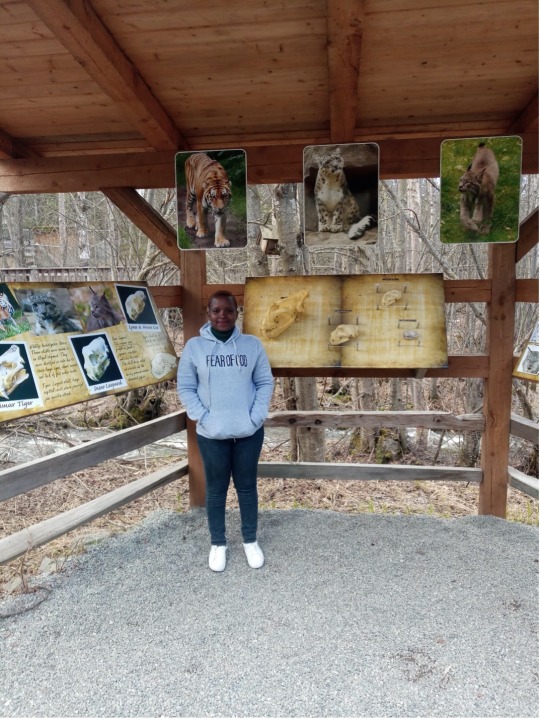
Clara stands outside the big cat exhibit at the Alaska Zoo
Cultural Immersion
I have learned many good things about the Alaskan indigenous heritage. I visited the Alaskan Native Heritage Center and learned about Alaskan cultures, architecture, traditional lands and languages, and creative arts, ranging from carving, basket weaving, and sewing to silver smiting. Amazing works represent Alaskan natives, including the underground houses they used to stay in and the equipment they used for hunting and fishing. I got to know the five native tribes: Athabascans, Inupiaqs, Yupiks, Aleuts, and the Northwest Coast Indians. I was so thrilled with my visit to Alaska, and I will definitely visit Alaska again and again.

Clara at the Alaskan Native Heritage Center, standing beside a totem for one of the Alaskan Native society
#professional fellows program#profellows#Institute for Community Inclusion#exchangeourworld#ExchangesMatter#citizen diplomacy#citizendiplomacy
0 notes
Text
Today In History:
A bit of May 28th history…
1830 - US President Jackson signs the Indian Removal Act, authorizing the army to force Cherokee, Chicksaw, Choctae, Creek, and Seminole tribes out of Georgia and surrounding states, setting stage for Cherokee Trail of Tears (pictured)
1892 - Sierra Club formed in San Francisco for conservation of nature
1929 - 1st all color talking picture “On With the Show” exhibited in NYC
1961 Amnesty International founded
1999 - In Milan, Italy, after 22 years of restoration work, Leonardo da Vinci’s “Last Supper” is put back on display
2016 - Harambe, a gorilla in the Cincinnati Zoo, is shot after dragging a 3 year old boy who had slipped into the enclosure (pictured below)
0 notes
Text

╞═════Journal • Writing═════╡
"THE LIFE OF PI" by Yann Martel
╞═════𖠁⬤𖠁═════╡


Title: Life of Pi
Author: Yann Martel
Characters: Pi Patel, Gita Patel, Santosh Patel, Ravi Pantel, Anandi, Pi's Wife
Theme: Life and Adventure
A boy who was stranded in the middle of the ocean with a tiger, zebra and a orangutan who co-exist with life.
Summary
Life of Pi is a novel written by Yann Martel about a young Indian boy, lost at the Pacific in a lifeboat and his only companion being a bengal tiger. It starts off in Pondicherry, India. His father owns a zoo, and he shows a great interest in animals and their behaviours as well as religion. His family decides to move to Canada, along with some of their animals from the zoo and their belongings. They are aboard a Japanese cargo ship. The ship later sinks in the midst of a storm, Pi being the only human survivors along with a zebra, orangutan, hyena and a bengal tiger. The hyena, zebra and orangutan all die and Pi is left with Richard Parker, the tiger. Pi talks about his struggles,routines, milestones on the lifeboat throughout the book, until they reach the shores of Mexico where Richard Parker took off with no goodbye. Leaving Pi in agony, he is brought to a hospital to recover where he meets two Japanese men investigating why the Tsimtsum Sank. He tells his story but the men do not believe him. Pi tells a different story that is more believable, leaving the reader wondering which story is a true representation of Pi’s experience on the lifeboat.
Moral Lesson
While reading The Life of Pi, it also give us some life lessons and one is that we need to "Learn to Coexist" with every living organism we encounter. Another is that having a "Plan is Essential, Not Optional" because we need to be ready on what kind of situation we will be in or the possibility of things that can happen around you and for that we need to be prepared and make a plan. Another is that "Forgiveness is the Right Choice", like in the book Pi forgives the Tiger for all the things he has from eating the Zebra and the Orangutan. He even forgives the tiger even after attempting to eat him. Another lesson that I learned from the story is that we always need to "Keep moving,Don't give up". Life is about ups and downs where there is a moment is our life when we fall but it doesn't mean that we need to give up we just need to stand and keep moving and the last lesson that I've learned from this story is that "Perspective Changes Everything". Every people has their own perspective on things even I have different perspectives on the things I see but have you tried believing in someone else's perspective?. Once you believe on someones else's perspectives, it changes more or rather expand your beliefs on how you see things like Pi in the story, his perspective changes everything when he found out that everything, including living and non-living things can change no matter how and just need the right way to do it.
0 notes
Text
Saving The Tigers

There are only fifty tigers left in the Panna reserve in Madhya Pradesh. No one knows how many tigers were killed in the cyclone Amphan that struck the Sunderbans two years before.
The tiger, living fire of the Indian forest, might soon be snuffed out forever. According to the latest National Tiger Conservation Authority’s report there are only 2937 tigers in the wild in the country. Indeed, the National Tiger Conservation Authority has added that its study has an error margin, which could bring the estimated tiger population down to less than 2,500. With human encroachments and poaching on the rise, the magnificent lord of the wilderness, rippling like liquid flame through the jungle, could face extinction unless drastic steps are taken.
How do we save the tiger? A number of practical measures have been suggested. Areas where the tigers remains the best protected, for example in Corbett National Park, Kanha National Park and Bandhavgarh National Park must have primary focus on forestation and anti-encroachment issue. Strict anti-encroachment laws must be enforced. Involving local communities in tiger preservation projects and provision of more sophiscated firearms to forest guards helps to curb poaching. Poaching of tigers must be made a crime equivalent to murder, carrying a life sentence and enforcing some lump fines such as 5 to 10 lakhs may help. Rewarding of informants who help in the apprehension and conviction of poachers while also ensuring them safety may also help in prevention of poaching. Synchronising an international clampdown on the clandestine, but booming trade in tiger skins and organs, the latter prized — particularly in China — for their supposedly aphrodisiacal qualities. Public arrest of influential people possessing the tiger skin can help in creating fear among the poachers.
All these measures could, and should, be adopted. But if the Indian tigers are to be preserved outside of zoos, perhaps the best hope of its survival would be is to get exported to a more economically advanced and environmentally conscious country where it can breed in the wild with minimal fear of poaching or diminution of its habitat through human encroachment.
The truth is that we have only too tragically proved that we don’t deserve the striped splendour of the tiger, any more than we do our man-made heritage of monuments and ancient artworks, many if not most of which are in a disgraceful state of malign neglect or have been spirited out of the country by smugglers, often aided and abetted by officials whose function it is precisely to prevent such theft.
It’s not just the tigers that are dying out. The Gir Lion, once the pride of Gujarat, has become a cruel travesty of its former glory. The population of lion has shrunk to a little more than 350, but there is a considerable rise in their population which alone seems hopeful.But the few pitiful survivors, overexposed to unchecked hordes of tourists and sightseers, have virtually been reduced to the status of domestic pets, gratefully accepting vegetarian snacks from "shudh shakahari" visitors.
Lions, tigers and leopards are not cuddly toys, to be figuratively hugged out of an access of dewy-eyed sentimentalism. Left unmolested in their natural habitat they are marvellously efficient predators, at the pinnacle of the food chain which in its totality ensures the overall health of the environment. This is the ecological and scientific rationale behind preservation: the pug mark as a medical certificate for the habitat as a whole.
Already we have laid waste to much of the big cats’ natural domain: far short of the government target of bringing 33 per cent of the total land area under tree cover, currently only 21.71 per cent of the country is forested, of which some 9.33 per cent is ‘open’ (degraded) forest. In the past two years, a 15,183-sq-km aggregate area of forest has been chopped down. We seem to be unable, or unwilling, or both, to save our forests. How do we then dare to presume that we can, or even want to, save the tiger? It’s like saying we want to save the child even as we busy ourselves destroying the physical and emotional landscape of childhood. That is, there is no use in trying to save the tigers unless we don't save their natural habitat.
Do we really want to save the tiger, other than as a zoological curio, a museum exhibit? Then export it en masse to less savagely exploitative climes. Else a future Blake could well write of us in scornful bewilderment:
Tiger! Tiger! dying light
In the forest of our blight,
What immoral land of lies
Could unframe thy wondrous symmetries?
By,
Bharath
0 notes
Text
Global Warming , Wildlife Conservation
Global warming
Global warming is the long-term warming of the planet's overall temperature. Though this warming trend has been going on for a long time, its pace has significantly increased in the last hundred years due to the burning of fossil fuels. As the human population has increased, so has the volume of fossil fuels burned.
CAUSES OF GLOBAL WARMING:
Global warming occurs when carbon dioxide (CO2) and other air pollutants collect in the atmosphere and absorb sunlight and solar radiation that have bounced off the earth’s surface. Normally this radiation would escape into space, but these pollutants, which can last for years to centuries in the atmosphere, trap the heat and cause the planet to get hotter. These heat-trapping pollutants—specifically carbon dioxide, methane, nitrous oxide, water vapor, and synthetic fluorinated gases—are known as greenhouse gases, and their impact is called the greenhouse effect.
EFFECTS OF GLOBAL WARMING:
Each year scientists learn more about the consequences of global warming, and each year we also gain new evidence of its devastating impact on people and the planet. As the heat waves, droughts, and floods associated with climate change become more frequent and more intense, communities suffer and death tolls rise. If we’re unable to reduce our emissions, scientist believe that climate change could lead to the deaths of more than 250,000 people around the globe every year and force 100 million people into poverty by 2030.
Global warming is already taking a toll on the United States. And if we aren’t able to get a handle on our emissions, here’s just a smattering of what we can look forward to:
Disappearing glaciers, early snowmelt, and severe droughts will cause more dramatic water shortages and continue to increase the risk of wildfires in the American West.
Rising sea levels will lead to even more coastal flooding on the Eastern Seaboard, especially in Florida, and in other areas such as the Gulf of Mexico.
Forests, farms, and cities will face troublesome new pests, heat waves, heavy downpours, and increased flooding. All of these can damage or destroy agriculture and fisheries.
Disruption of habitats such as coral reefs and alpine meadows could drive many plant and animal species to extinction.
Allergies, asthma, and infectious disease outbreaks will become more common due to increased growth of pollen-producing ragweed, higher levels of air pollution, and the spread of conditions favorable to pathogens and mosquitoes.
WILDLIFE CONSERVATION
The wildlife conservation is a method of protecting wild species and their natural habitat from the various threats like poaching, killing, smuggling etc. by protecting them; we can enhance, restore and protect the ecosystem.
For wildlife conservation, many efforts have been taken at the international and national level. Many NGO’s are working towards wildlife conservation.
Convention on International Trade in Endangered Species of Wild Flora and Fauna (commonly known as CITES) in 1973 is one of the prominent agreements at International level. It lists the various species into different -different categories.
IN- SITU CONSERVATION: In this, the species remain in their natural habitats and the places is protected through protecting the whole ecosystem of the place—example: wildlife sanctuary.
EX- SITU CONSERVATION: In this, the protection of biodiversity or wild animals are taken from their natural habitat and transferred to a new place. Example: the zoo.
Efforts Made by Indian Government for Wildlife Conservation:
PROJECT TIGER - It is a centrally sponsored scheme launched in 1973 for the conservation of Indian Tiger which is endangered. The Tiger population has been reduced from many last decades.
For this, the National Tiger Conservation Authority is constituted. The program started with 9 Tiger reserve, and presently it is approximately 20. Tiger census has occurred in every four years.
PROJECT ELEPHANT - It is also a centrally sponsored scheme and launched in 1992. It is implemented in 13 states. Under this, 88 Elephants corridors were set up.
Haathi Mere Saathi scheme was also launched by the Ministry of Environment, Forest and Climate Change in partnership with wildlife trust of India.
SEA TURTLE PROJECT - It was launched by Ministry of Environment, Forest and Climate Change in collaboration with UNDP in 1999. The Olive Ridley Turtle visits India during Winter.
The implementing agency of this project is the Wildlife Institute of India. It is in the Vulnerable in IUCN list.
CROCODILE CONSERVATION PROJECT - The main aim of this project is to protect the remaining population of crocodiles in their natural habitat.
“Ghariyal” is listed as Critically Endangered in IUCN list.
PROJECT DOLPHIN - Ministry of Environment, Forest and Climate Change has notified Ganges River Dolphin as National Aquatic animal. It was listed in Schedule I of Wildlife Protection Act 1972.
Major threat: river water pollution, poaching and siltation.
Conclusion:
Wildlife conservation is necessary for sustainable development. Various efforts have been made at the international and national level. In India also various efforts have been made like: project Tiger, Project Elephant, Captive breeding program etc. India also adopts various methods and policies at international level or in the line of international agreements and convention.
0 notes
Text
How did Indira Gandhi contribute to wildlife conervation?
Indra Priyadarshini Gandhi, the second Prime Minister of India, is associated with some of nation’s most turbulent phases. From declaring the 1975 Emergency to conducting Operation Blue Star in 1983, Indira Gandhi was at the forefront of several controversies. However, she also has been accredited with some of India’s finest achievements. This includes the liberation of Bangladesh in 1971 and India’s first nuclear test in 1974 . However, one of her more significant, yet lesser known, legacies include the revolutionization of wildlife conservation in India. Some of India’s most successful wildlife revival projects, such as “Project Tiger “, commenced under the leadership of Indra Gandhi.
Indira Gandhi fought valiantly to protect India’s wildlife from recreational hunting, particularly by redundant Indian Monarchs. The sport was evidently a product of colonial hangover, as the British Colonials notoriously decimated populations of India’s wildlife for their leisurely ventures.
Wildlife Protection Act (1972)
The enactment of the Wildlife Protection Act of 1972 is probably the most significant contribution of Gandhi. The reform established the necessity to protect both plant and animal species across the country. The hunting and trade of wildlife native to India was debarred. As a part of the act, six schedules (categories) of wildlife were established based on species rarity. Punishment for crimes against wildlife varied based on which schedule the animal was classified under.
The act provided provisions for the establishment of the National Tiger Conservation Authority, National Board of Wildlife and Central Zoo Authority. Water Pollution Act 1974, Forest Conservation Act 1980 and the Air Protection Act 1981 are few other policies enacted by Gandhi.
The Wildlife Protection Act has been a wonderful success story. At the time of legislation, India only had 5 designated national parks. Nearly half a century later, India has over 100 national parks, covering the entire breadth of her geography. Numerous highly endangered species have since staged remarkable comebacks from the cusps of extinction. This includes the Gir Lion, Asiatic Elephant and Indian Rhino. However, despite its success, the Act remains imperfect and has been subject to significant modifications. In fact, the act has had seven amendments, predominantly in recent decades. Unfortunately, the Act also failed to account forIndia’s Dying Grasslands.
Project Tiger
Gandhi is also credited with reviving the Bengal Tiger population from the brink of extinction through “Project Tiger”, which was launched by her government in April 1973, at Jim Corbett National Park. It has been a prominent conservation project which has yielded unprecedented results. The program commenced at a time when the future of the Bengal Tiger population was dwindling. At the advent of the 20 thCentury, the tiger population was approximately 50,000. But, by 1972, the population had plummeted to around 1,200 tigers.
The program aimed to address two aspects of tiger conservation. The first was to establish a viable tiger population for ecological, economic and cultural values. The second objective was to safeguard the range of the Bengal tiger. This was through the protection of intact habitat and the revival of degraded ecosystems. Project Tiger certainly reaped significant benefits, with the population staging a wonderful comeback.
According to the 2019 census, tiger populations in the country just fell short of the 3,000 mark, approximately doubling in the preceding decade. The number of tiger reserves in the country has also increased substantially from 9 In 1973, covering a mere 18,000km 2to 51 in present day covering over 70,000 km 2. Despite its success, Project Tiger has suffered from numerous setbacks such as human wildlife conflict, tribal rights and poaching. Nonetheless, the project continues to evolve and forms the benchmark for its contemporary counterparts.
Indian Crocodile Conservation Project
On similar grounds, the Indian Crocodile Conservation Project was established in 1975 with a focus on habitat improvement, community involvement, captive breeding and the subsequent reintroduction, the project is amongst the most remarkable conservational stories of the last century. The Saltwater crocodile witnessed a 15 fold increase in population from under a hundred in 1976 to over 1,600 in 2012 and Marsh crocodile populations have nearly tripled since 1989. The project has recently also provided a ray of hope for the critically endangered Indian Gharial Population, with its population doubling between 2012 and 2019.
Indira Gandhi’s Shortcomings
However, Gandhi’s contributions to the environment were not perfect. Her environmental policies, especially those linked with the Wildlife Protection Act and Project Tiger, encouraged the dissociation of humanity from nature. Despite centuries of successful coexistence of indigenous communities with nature, the rights of tribal communities suffered. Fortunately, in recent years, community based conservation has garnered significant interest and has yielded positive results.
Another shortcoming of Gandhi’s environmental policies was her support of infrastructure projects that were disastrous for the environment. For example, she commissioned Indian Oil’s Mathura Refinery. According to a panel hired by the Indian Government, the factory emissions and automobile exhausts are likely to have augmented the pollution of the nearby Taj Mahal. Furthermore, her indifference to the environmental impacts of the Kudremukh Iron Ore Mining Project has proven to be one of the nation’ largest ecological catastrophes. The most relevant criticism of Gandhi’s environment outlook, is her execution of India’s Green Revolution. The usage of insecticides and pesticides have skyrocketed and caused immense ecological damage.
Nonetheless, Indira Gandhi’s overall contribution to India’s environment, particularly wildlife, was unprecedented, as she laid the foundation of India’s ever evolving conservation success in a period of immense geopolitical and economic fragility. Currently India has launched numerous ambitious conservation projects. This includes thereintroduction of cheetahs.Without India’s most controversial Prime Minister, this day would never have been.
Help us Help Them! Think Wildlife Foundation is a non profit organization with various conservation initiatives. Our most prominent campaign is our Caring for Pari intiative. Pari is a rehabilitated elephant at the Wildlife SoS Hospital. 25% of the profits from our store are donated to the elephant hospital for Pari. Other than buying our wonderful merchandise, you could donate directly to our Caring For Pari fundraiser.
Originally published at https://thinkwildlifefoundation.com on May 21, 2021.
0 notes